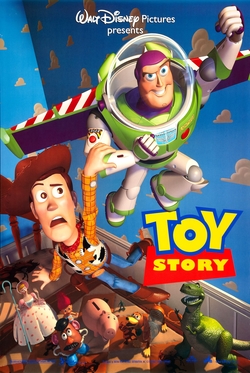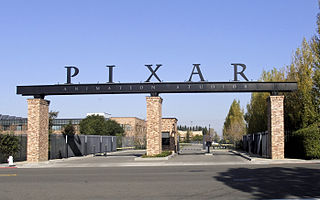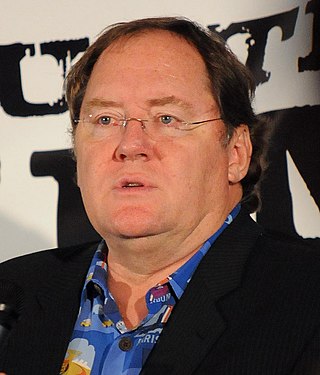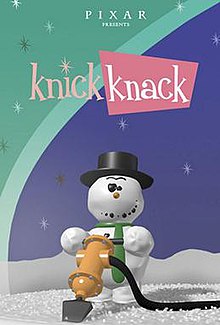
Toy Story is a 1995 American animated comedy film produced by Pixar Animation Studios for Walt Disney Pictures. The first installment in the franchise of the same name, it was the first entirely computer-animated feature film, as well as the first feature film from Pixar. It was directed by John Lasseter and produced by Bonnie Arnold and Ralph Guggenheim, from a screenplay written by Joss Whedon, Andrew Stanton, Joel Cohen, and Alec Sokolow and a story by Lasseter, Stanton, Pete Docter, and Joe Ranft. The film features music by Randy Newman, and was executive-produced by Steve Jobs and Edwin Catmull. The film features the voices of Tom Hanks, Tim Allen, Don Rickles, Jim Varney, Wallace Shawn, John Ratzenberger, Annie Potts, R. Lee Ermey, John Morris, Laurie Metcalf, and Erik von Detten.

Pixar Animation Studios is an American animation studio based in Emeryville, California, known for its critically and commercially successful computer-animated feature films. Since 2006, Pixar has been a subsidiary of Walt Disney Studios, a division of Disney Entertainment, a segment of the Walt Disney Company.
Modern animation in the United States from the late 1980s to the early 2000s is frequently referred to as the renaissance age of American animation. During this period, many large American entertainment companies reformed and reinvigorated their animation departments, following the dark age, and the United States had an overall profound effect on animation globally.

Tin Toy is a 1988 American animated short film produced by Pixar and directed by John Lasseter. The short film, which runs for five minutes, stars Tinny, a tin one-man band toy, trying to escape from Billy, a human baby. The third short film produced by the company's small animation division, it was a risky investment: due to the low revenue produced by Pixar's main product, the Pixar Image Computer, the company was under financial constraints.

Luxo Jr. is a 1986 American animated short film produced and released by Pixar. Written and directed by John Lasseter, the two-minute short film revolves around one larger and one smaller desk lamp. The larger lamp, named Luxo Sr., looks on while the smaller, "younger" Luxo Jr. plays exuberantly with a ball to the extent that it accidentally deflates. Luxo Jr. was Pixar's first animation after Ed Catmull and John Lasseter left the Lucasfilm Computer Division. The film is the source of Luxo Jr., the mascot of Pixar.

Geri's Game is a 1997 American animated short film produced by Pixar and written and directed by Jan Pinkava. The short, which shows an elderly man named Geri who competes with himself in a game of chess, was Pixar's first film to feature a human being as its main character; Geri later made a cameo appearance in Toy Story 2 as "The Cleaner", here voiced by Jonathan Harris instead of Bob Peterson.

John Alan Lasseter is an American film director, producer, and animator. He has served as the Head of Animation at Skydance Animation since 2019. Previously, he acted as the chief creative officer of Pixar Animation Studios, Walt Disney Animation Studios, and Disneytoon Studios, as well as the Principal Creative Advisor for Walt Disney Imagineering.

Walt Disney Animation Studios (WDAS), sometimes shortened to Disney Animation, is an American animation studio that creates animated features and short films for The Walt Disney Company. The studio's current production logo features a scene from its first synchronized sound cartoon, Steamboat Willie (1928). Founded on October 16, 1923, by brothers Walt Disney and Roy O. Disney, it is the oldest-running animation studio in the world. It is currently organized as a division of Walt Disney Studios and is headquartered at the Roy E. Disney Animation Building at the Walt Disney Studios lot in Burbank, California. Since its foundation, the studio has produced 62 feature films, from Snow White and the Seven Dwarfs (1937) to Wish (2023), and hundreds of short films.

Red's Dream is a 1987 American animated short film written and directed by John Lasseter and produced by Pixar. The short film, which runs four minutes, stars Red, a unicycle. Propped up in the corner of a bicycle store on a rainy night, Red dreams of a fantasy where it becomes the star of a circus. Red's Dream was Pixar's second computer-animated short following Luxo Jr. in 1986, also directed by Lasseter.

The Adventures of André & Wally B. is a 1984 American animated short film produced by the Lucasfilm Computer Graphics Project, a division of Lucasfilm and the predecessor of Pixar. The short was groundbreaking by the standards of the time and helped spark the film industry's interest in computer animation.

Andrew Ayers Stanton is an American filmmaker and voice actor based at Pixar, which he joined in 1990. His film work includes co-writing and co-directing Pixar's A Bug's Life (1998), directing Finding Nemo (2003) and its sequel Finding Dory (2016), WALL-E (2008), and the live-action film, Disney's John Carter (2012), and co-writing all four Toy Story films (1995–2019) and Monsters, Inc. (2001).

Circle Seven Animation was a short-lived division of Walt Disney Feature Animation specializing in computer-generated imagery (CGI) animation and was originally intended to create sequels to the Disney-owned Pixar properties, leading rivals and animators to derisively nickname the division "Pixaren't". The studio did not release any films during its existence, nor were any of its scripts used by Pixar.

Tiny Toy Stories is a home video compilation of five computer-animated short films made by Pixar. It was released on October 29, 1996, by Walt Disney Home Video and Disney Videos internationally. The International releases, including the UK and Japan, have the Toy Story characters hosting it and talking about the shorts. Additionally, the international releases have Knick Knack and Tin Toy switched, to exemplify how "without Tin Toy, there would've been no Toy Story".

William "Bill" Reeves is a Canadian animator and technical director known for working with John Lasseter on the animated shorts Luxo Jr. and The Adventures of André and Wally B.
Eben Fiske Ostby is a pioneer computer graphics software developer, animator, and technical director for motion pictures.

Pixar Short Films Collection, Volume 1 is a home video compilation released by Walt Disney Home Entertainment on November 6, 2007, containing 13 of Pixar's short films. It was followed by Pixar Short Films Collection, Volume 2, which was released on November 6, 2012, and Pixar Short Films Collection, Volume 3, which was released on November 6, 2018.

Toy Story is an American media franchise owned by The Walt Disney Company. It centers on toys that, unknown to humans, are secretly living, sentient creatures. It began in 1995 with the release of the animated feature film of the same name, which focuses on a diverse group of toys featuring a classic cowboy doll named Sheriff Woody and a modern spaceman action figure named Buzz Lightyear.

Luxo Jr. is a semi-anthropomorphic toy desk lamp character used as the primary mascot of Pixar Animation Studios. He is the protagonist of the short film Luxo Jr. and appears on the production logo of every Pixar film, hopping into view and jumping on the capital letter "I" in "PIXAR" to flatten it. John Lasseter created the character, modeling it after his own Luxo brand lamp. In 2009, the manufacturer of Luxo lamps sued Disney, the parent company of Pixar, for selling Luxo Jr.-branded merchandise.















